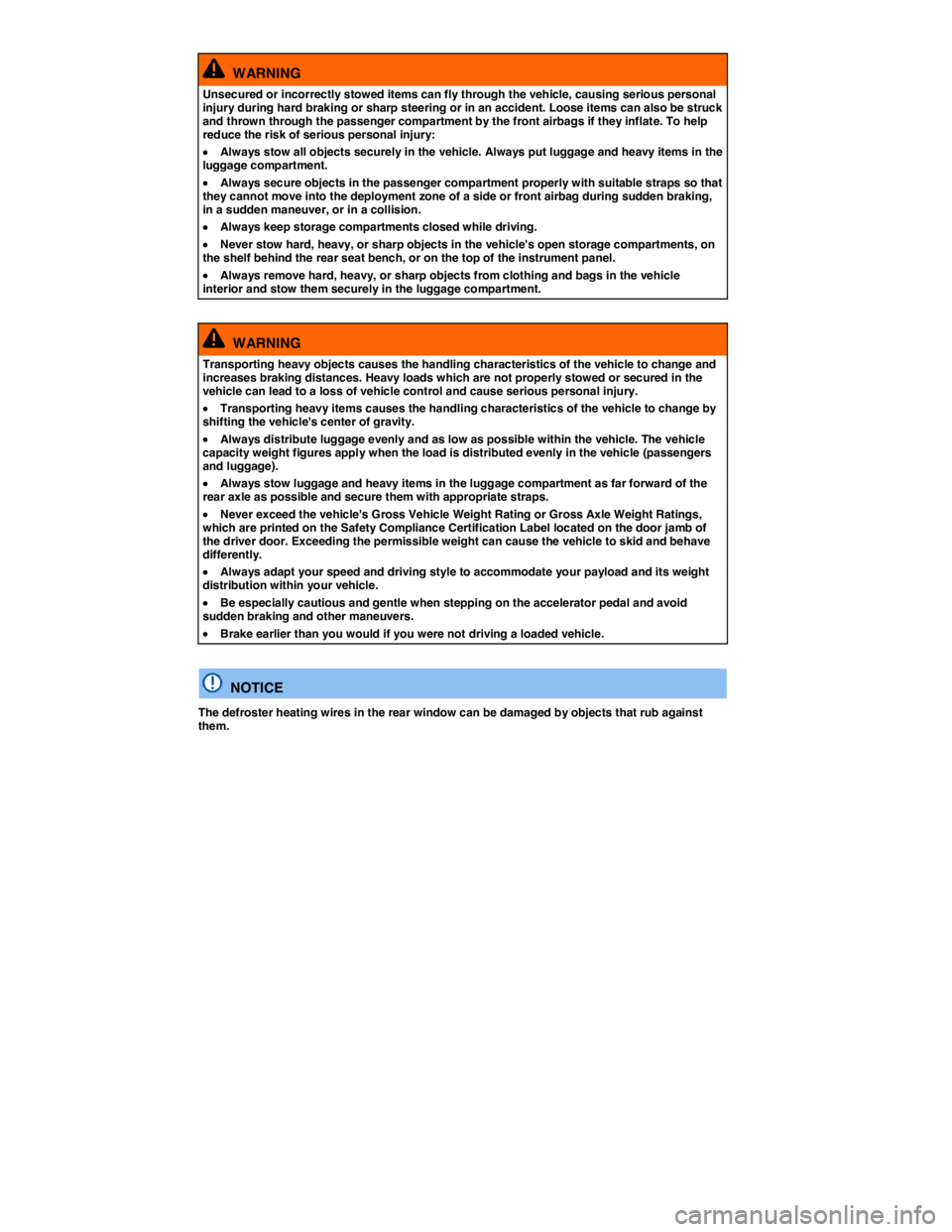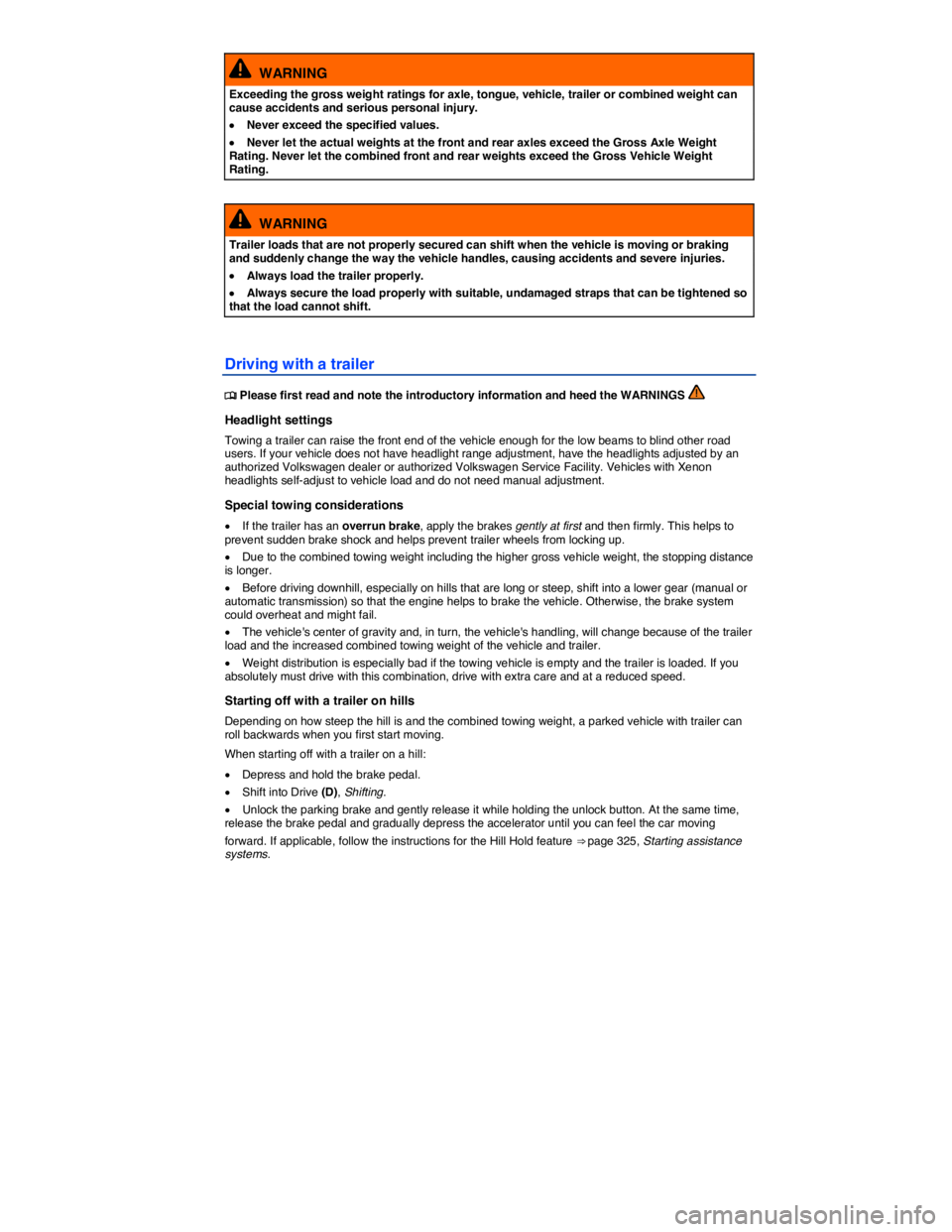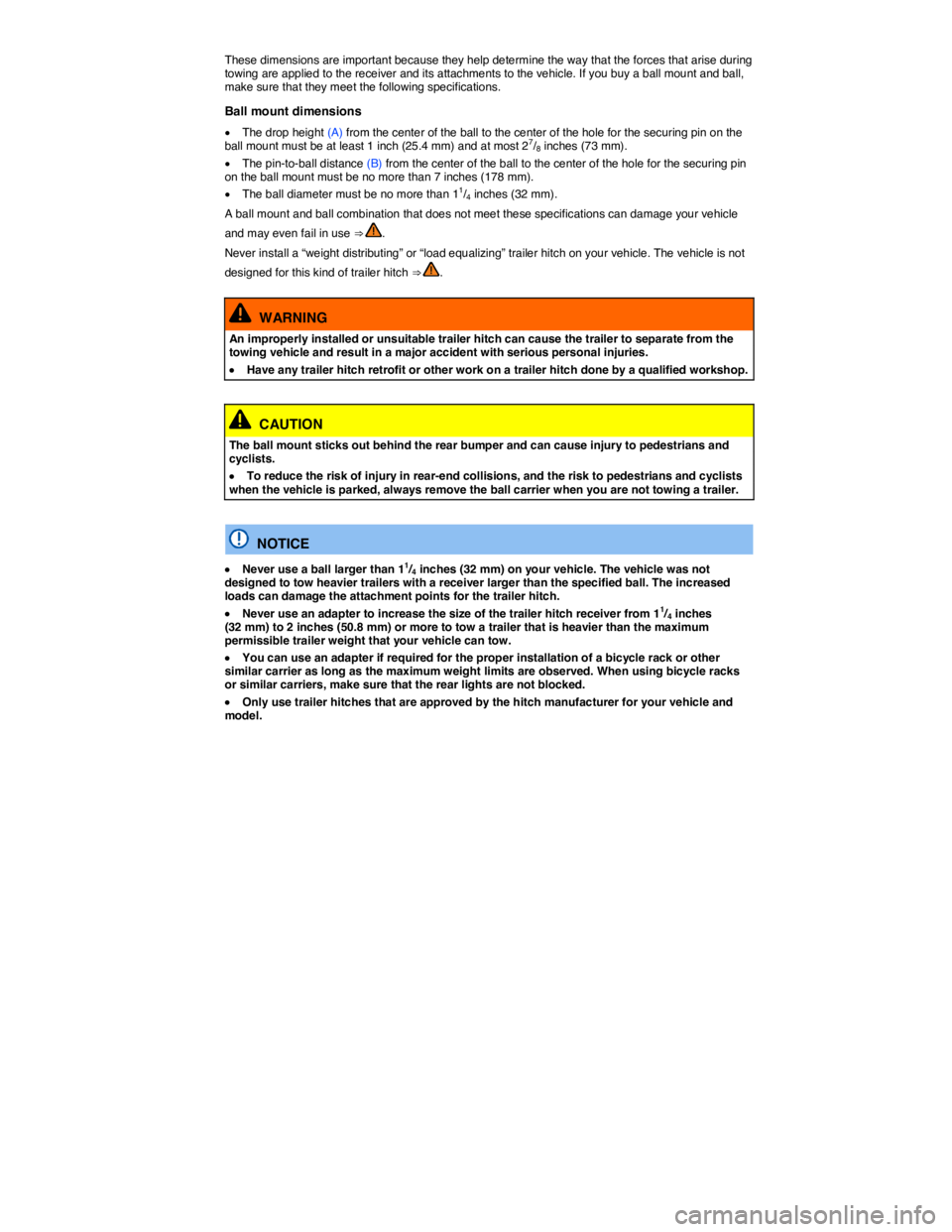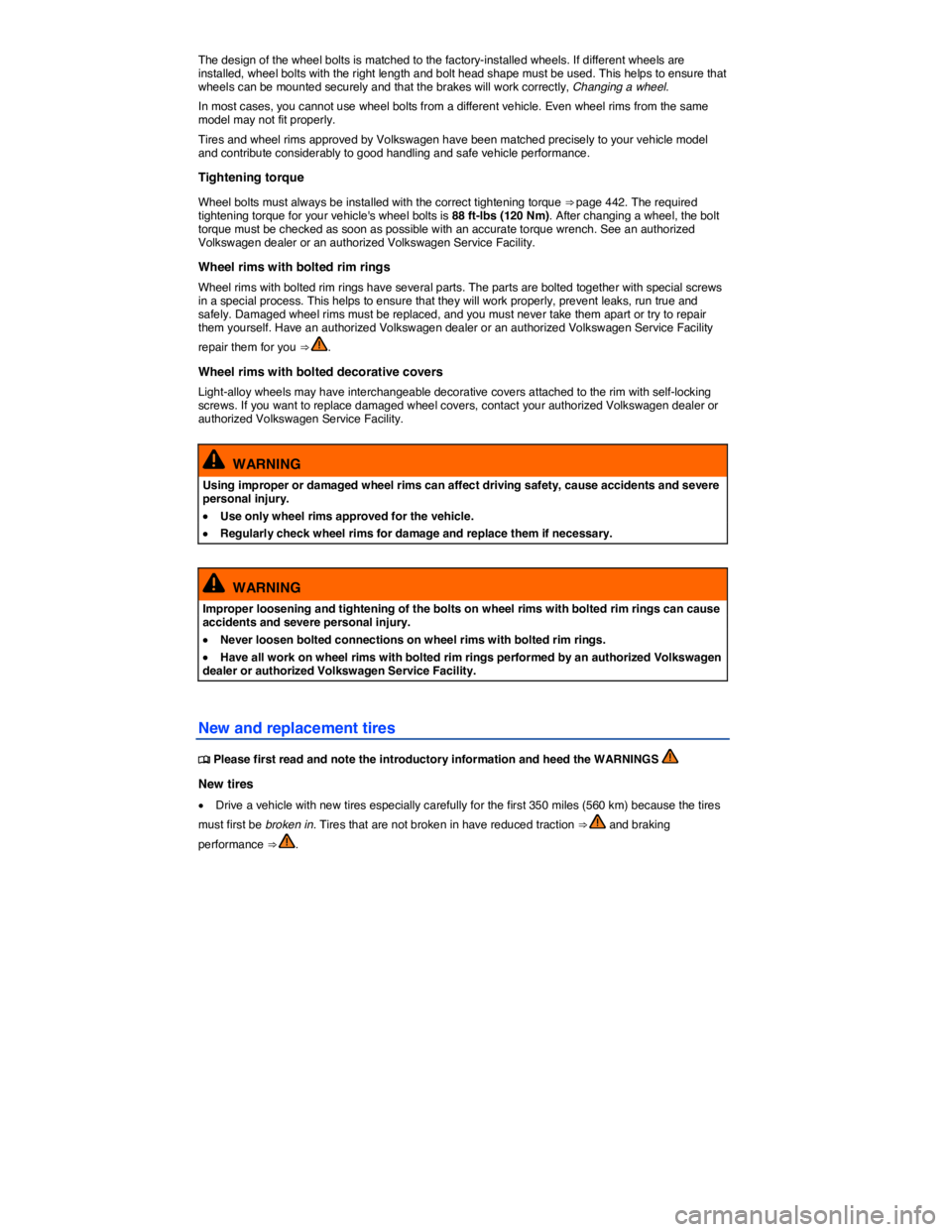2007 VOLKSWAGEN EOS ECU
[x] Cancel search: ECUPage 129 of 381

WARNING
Heavy loads will influence the way your vehicle handles and increase stopping distances. Heavy loads that are not properly stowed or secured can cause loss of control and serious injury.
�x Secure the load properly to keep it from shifting.
�x Always remember when transporting heavy objects that a change in the center of gravity also changes the way your vehicle handles:
– Always distribute the load as evenly as possible.
– Secure heavy objects properly as far forward in the luggage compartment as possible.
– Always tie down heavy items securely with suitable straps in the luggage compartment.
�x Never exceed the Gross Axle Weight Rating or the Gross Vehicle Weight Rating on the safety compliance sticker on the left door jamb. Exceeding permissible weight can cause the vehicle to skid and handle differently.
�x Always adapt your speed and driving to the heavier load and the weight distribution in the vehicle. Take road, weather, traffic, and visibility conditions into account as well.
�x Always accelerate gently and avoid sudden braking and driving maneuvers.
�x Always brake earlier than you would if you were not driving a loaded vehicle.
NOTICE
�x When the CSC roof opens (goes down), it folds completely into the luggage compartment. The open CSC roof fills all the space above and on both sides of the cover that is installed inside the luggage compartment. When the CSC roof opens and retracts, it must be able to lower itself completely into the luggage compartment without any interference.
�x When you put the roof down, items
– to the left or right of the luggage compartment cover,
– on top of the luggage compartment cover, or
– above the level of the luggage compartment cover at the rear of the vehicle will prevent the roof from folding up completely in the luggage compartment and will damage the CSC roof. Damage to the CSC roof caused by items in those areas of the luggage compartment where the CSC roof segments are stored when retracted will not be covered by any Volkswagen Limited Warranty.
�x The heating wires in the rear window can be severely damaged by hard or sharp things in the area below the rear window.
Page 134 of 381

WARNING
Heavy loads can change the way your vehicle handles and increase stopping distances. Heavy loads that are not properly stowed or secured can shift suddenly, causing loss of control and serious injury.
�x Secure the load properly to keep it from shifting.
�x Always remember when transporting heavy objects that they change the vehicle's center of gravity and also the way it handles.
– Always distribute the load as evenly as possible.
– Secure heavy objects as far forward in the luggage compartment as possible.
�x Always tie down heavy items securely with suitable straps.
�x Never exceed the Gross Axle Weight Rating or the Gross Vehicle Weight Rating on the safety compliance sticker on the left door jamb. Exceeding permissible weight can cause the vehicle to skid and handle differently.
�x Always adapt speed and driving to the heavier load and the weight distribution in the vehicle. Take road, weather, traffic, and visibility conditions into account as well.
�x Always accelerate gently and avoid sudden braking and driving maneuvers.
�x Always brake earlier than you would if you were not driving a loaded vehicle.
Weights and axle weights
�
Page 137 of 381

WARNING
Unsecured or incorrectly stowed items can fly through the vehicle, causing serious personal injury during hard braking or sharp steering or in an accident. Loose items can also be struck and thrown through the passenger compartment by the front airbags if they inflate. To help reduce the risk of serious personal injury:
�x Always stow all objects securely in the vehicle. Always put luggage and heavy items in the luggage compartment.
�x Always secure objects in the passenger compartment properly with suitable straps so that they cannot move into the deployment zone of a side or front airbag during sudden braking, in a sudden maneuver, or in a collision.
�x Always keep storage compartments closed while driving.
�x Never stow hard, heavy, or sharp objects in the vehicle's open storage compartments, on the shelf behind the rear seat bench, or on the top of the instrument panel.
�x Always remove hard, heavy, or sharp objects from clothing and bags in the vehicle interior and stow them securely in the luggage compartment.
WARNING
Transporting heavy objects causes the handling characteristics of the vehicle to change and increases braking distances. Heavy loads which are not properly stowed or secured in the vehicle can lead to a loss of vehicle control and cause serious personal injury.
�x Transporting heavy items causes the handling characteristics of the vehicle to change by shifting the vehicle's center of gravity.
�x Always distribute luggage evenly and as low as possible within the vehicle. The vehicle capacity weight figures apply when the load is distributed evenly in the vehicle (passengers and luggage).
�x Always stow luggage and heavy items in the luggage compartment as far forward of the rear axle as possible and secure them with appropriate straps.
�x Never exceed the vehicle's Gross Vehicle Weight Rating or Gross Axle Weight Ratings, which are printed on the Safety Compliance Certification Label located on the door jamb of the driver door. Exceeding the permissible weight can cause the vehicle to skid and behave differently.
�x Always adapt your speed and driving style to accommodate your payload and its weight distribution within your vehicle.
�x Be especially cautious and gentle when stepping on the accelerator pedal and avoid sudden braking and other maneuvers.
�x Brake earlier than you would if you were not driving a loaded vehicle.
NOTICE
The defroster heating wires in the rear window can be damaged by objects that rub against them.
Page 143 of 381

WARNING
Improper use of the trailer hitch can cause accidents and injuries. An improperly installed, incorrect, or damaged trailer hitch can cause the trailer to separate from the towing vehicle and cause serious personal injuries.
�x Only use an undamaged, properly mounted trailer hitch.
�x Never repair or modify the trailer hitch.
�x To reduce the risk of injury in rear-end collisions, and the risk to pedestrians and cyclists when the vehicle is parked, always remove the ball mount when you are not towing a trailer.
�x Never install a “weight distributing” or “load equalizing” trailer hitch on your vehicle. The vehicle was not designed for these kinds of trailer hitches. The trailer hitch attachment can fail, causing the trailer to tear loose from the vehicle.
WARNING
Improper trailer towing can cause loss of vehicle control and serious personal injury.
�x Driving with a trailer and carrying heavy or large things can change the way the vehicle handles, increase the distance it needs to stop safely, and cause accidents.
�x Always secure the load properly with suitable and undamaged straps so that the load will not shift.
�x Always adapt your speed and driving to the heavier load and the weight distribution in the vehicle. Take road, weather, traffic, and visibility conditions into account as well.
�x Reduce your speed even more than you otherwise would when going downhill and under unfavorable load, weather, or wind conditions.
�x Trailers with a high center of gravity tip more easily than trailers with a low center of gravity.
�x Always avoid sudden maneuvers and hard braking.
�x Be especially careful when passing other vehicles.
�x Reduce speed immediately if the trailer shows the slightest sign of swaying.
�x Never try to stop the swaying by accelerating.
�x Always obey speed limits. In some areas, the speed limits for vehicles towing trailers are lower than for vehicles without trailers. Never drive faster than 50 mph (80 km/h; under exceptional circumstances 60 mph - 100 km/h) when towing a trailer. This applies even if the local speed limit is higher.
If you are driving a new vehicle or a vehicle with a new or rebuilt engine, do not tow a trailer during the break-in period, about 600 miles (1000 km), Parts, accessories, repairs, and modifications.
If you tow a trailer, your vehicle may need maintenance more often because of the extra load it has to move.
When you are not towing, remove the trailer hitch ball. This helps keep the trailer hitch from causing damage to your vehicle and to others if your vehicle is hit from behind.
Some models need a trailer hitch to tow or tow-start other vehicles. You may want to always carry the ball mount in the vehicle after it has been removed. Be sure to stow it securely.
Page 147 of 381

WARNING
Exceeding the gross weight ratings for axle, tongue, vehicle, trailer or combined weight can cause accidents and serious personal injury.
�x Never exceed the specified values.
�x Never let the actual weights at the front and rear axles exceed the Gross Axle Weight Rating. Never let the combined front and rear weights exceed the Gross Vehicle Weight Rating.
WARNING
Trailer loads that are not properly secured can shift when the vehicle is moving or braking and suddenly change the way the vehicle handles, causing accidents and severe injuries.
�x Always load the trailer properly.
�x Always secure the load properly with suitable, undamaged straps that can be tightened so that the load cannot shift.
Driving with a trailer
�
Page 149 of 381

These dimensions are important because they help determine the way that the forces that arise during towing are applied to the receiver and its attachments to the vehicle. If you buy a ball mount and ball, make sure that they meet the following specifications.
Ball mount dimensions
�x The drop height (A) from the center of the ball to the center of the hole for the securing pin on the ball mount must be at least 1 inch (25.4 mm) and at most 27/8 inches (73 mm).
�x The pin-to-ball distance (B) from the center of the ball to the center of the hole for the securing pin on the ball mount must be no more than 7 inches (178 mm).
�x The ball diameter must be no more than 11/4 inches (32 mm).
A ball mount and ball combination that does not meet these specifications can damage your vehicle
and may even fail in use ⇒ .
Never install a “weight distributing” or “load equalizing” trailer hitch on your vehicle. The vehicle is not
designed for this kind of trailer hitch ⇒ .
WARNING
An improperly installed or unsuitable trailer hitch can cause the trailer to separate from the towing vehicle and result in a major accident with serious personal injuries.
�x Have any trailer hitch retrofit or other work on a trailer hitch done by a qualified workshop.
CAUTION
The ball mount sticks out behind the rear bumper and can cause injury to pedestrians and cyclists.
�x To reduce the risk of injury in rear-end collisions, and the risk to pedestrians and cyclists when the vehicle is parked, always remove the ball carrier when you are not towing a trailer.
NOTICE
�x Never use a ball larger than 11/4 inches (32 mm) on your vehicle. The vehicle was not designed to tow heavier trailers with a receiver larger than the specified ball. The increased loads can damage the attachment points for the trailer hitch.
�x Never use an adapter to increase the size of the trailer hitch receiver from 11/4 inches (32 mm) to 2 inches (50.8 mm) or more to tow a trailer that is heavier than the maximum permissible trailer weight that your vehicle can tow.
�x You can use an adapter if required for the proper installation of a bicycle rack or other similar carrier as long as the maximum weight limits are observed. When using bicycle racks or similar carriers, make sure that the rear lights are not blocked.
�x Only use trailer hitches that are approved by the hitch manufacturer for your vehicle and model.
Page 156 of 381

The design of the wheel bolts is matched to the factory-installed wheels. If different wheels are installed, wheel bolts with the right length and bolt head shape must be used. This helps to ensure that wheels can be mounted securely and that the brakes will work correctly, Changing a wheel.
In most cases, you cannot use wheel bolts from a different vehicle. Even wheel rims from the same model may not fit properly.
Tires and wheel rims approved by Volkswagen have been matched precisely to your vehicle model and contribute considerably to good handling and safe vehicle performance.
Tightening torque
Wheel bolts must always be installed with the correct tightening torque ⇒ page 442. The required tightening torque for your vehicle's wheel bolts is 88 ft-lbs (120 Nm). After changing a wheel, the bolt torque must be checked as soon as possible with an accurate torque wrench. See an authorized Volkswagen dealer or an authorized Volkswagen Service Facility.
Wheel rims with bolted rim rings
Wheel rims with bolted rim rings have several parts. The parts are bolted together with special screws in a special process. This helps to ensure that they will work properly, prevent leaks, run true and safely. Damaged wheel rims must be replaced, and you must never take them apart or try to repair them yourself. Have an authorized Volkswagen dealer or an authorized Volkswagen Service Facility
repair them for you ⇒ .
Wheel rims with bolted decorative covers
Light-alloy wheels may have interchangeable decorative covers attached to the rim with self-locking screws. If you want to replace damaged wheel covers, contact your authorized Volkswagen dealer or authorized Volkswagen Service Facility.
WARNING
Using improper or damaged wheel rims can affect driving safety, cause accidents and severe personal injury.
�x Use only wheel rims approved for the vehicle.
�x Regularly check wheel rims for damage and replace them if necessary.
WARNING
Improper loosening and tightening of the bolts on wheel rims with bolted rim rings can cause accidents and severe personal injury.
�x Never loosen bolted connections on wheel rims with bolted rim rings.
�x Have all work on wheel rims with bolted rim rings performed by an authorized Volkswagen dealer or authorized Volkswagen Service Facility.
New and replacement tires
�
Page 157 of 381

�x Install only radial tires of the same make, the same dimensions (tread circumference), and similar tread profile on all 4 wheels.
�x The tread depth of new tires can differ between tire models and manufacturers because of different design features and tread design.
Replacing tires
�x Tires should be replaced in pairs and not individually (both front tires or both rear tires at the same
time) ⇒ .
�x Replace tires only with tires that have the same specifications, including width and diameter, load and top speed rating as the tires approved by Volkswagen for your vehicle and model.
�x Never use tires that are larger or wider than the dimensions of the tires approved by Volkswagen for your vehicle and model. Larger tires could scrape and rub on the vehicle body or other parts of the vehicle.
Tire Pressure Monitoring System (TPMS) considerations
Factory-installed wheels are equipped with a sensor that constantly monitors tire pressure, then transmits this information to the TPMS, Tire Pressure Monitoring System (TPMS). If you are going to replace the wheels, make sure that the new wheels also have sensors that are compatible with the TPMS on your vehicle. New wheels with sensors have to be recognized and integrated into the system. To detect the new wheels and sensors, you must leave the vehicle parked for at least 20 minutes and then drive for a short time at speeds above 15 mph (25 km/h).
If you install wheels that do not have sensors, or have sensors that are not compatible, the TPMS will not work properly. In this case, the TPMS will not be able to monitor tire pressure or warn you if pressure is low. An error message may appear in the instrument cluster display or the TPMS will switch itself off.
�x Whenever you change sensors, you have to install new valves and seals. Please see an authorized Volkswagen dealer of an authorized Volkswagen Service Facility.
�x Always drive with the valve caps securely installed. We recommend using factory-supplied valve caps. Ask an authorized Volkswagen dealer or an authorized Volkswagen Service Facility to replace lost caps.
If you install new tires that differ from the original Volkswagen specifications for your vehicle and model, the benchmark tire inflation pressure values stored in your vehicle's TPMS may have to be adjusted (reprogrammed). This requires professional assistance. For more information, contact your authorized Volkswagen dealer or authorized Volkswagen Service Facility.
Installing replacement tires with steel cord body plies in the tire sidewall may cause a TPMS malfunction and is not recommended (cord material information is molded on the tire sidewall).
Always check the TPMS indicator light after replacing one or more tires on your vehicle. If the indicator light is on, the TPMS is not working properly. Your replacement tire might be incompatible with the system or some component of the TPMS may be damaged.
For detailed information about the TPMS, how it works, and what you need to know, Tire Pressure Monitoring System (TPMS).
WARNING
New tires tend to be slippery and must be broken in.
�x Always drive with special care for the first 350 miles (560 km) to help reduce the risk of losing control, a collision, and serious personal injuries.